|
Data used in the analyses below (ecological condition, threat status, protection, distribution of activities, cumulative pressure from activities) are from the National Biodiversity Assessment 2018: Marine Realm Assessment. See the NBA 2018 website for access to the report.
|
EBSA Status Assessment and Management Recommendations
Ecological Condition, Threat Status, Current Protection and Key Features in the EBSA
Relevant Pressures and Activities (impact, extent) | Management Interventions Needed for the EBSA
Activity Evaluation Per Zone: Zoning Feasibility | Management recommendations for MPAs
Management recommendations for MSP | Research Needs & Future Process
EBSA report download | Back to the SA EBSA status and management home page
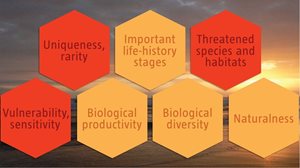
Kingklip Corals is collection of several newly discovered benthic features that seem to be connected: Secret Reef is an untrawled biogenic coral reef structure, linked to a unique rocky ridge and undersea hills; all of which support fragile species. Above the ridge are dense clouds of plankton and hake. The unique Kingklip Ridge and Kingklip Koppies ecosystem types are both threatened.
Click here for the full EBSA description
[Top]
Kingklip Corals comprises interesting and unique features and ecosystem types that need to be protected for the area to maintain the characteristics that give it its EBSA status. The criteria for which this EBSA ranks highly are: uniqueness and rarity, importance for threatened species and habitats, and vulnerability and sensitivity. There are five ecosystem types represented that contain fragile species, like corals, that are especially sensitive to damage. Two of the ecosystem types are unique to the area, and are threatened. The features and diversity within EBSA are not well known because they are so newly discovered, but it’s likely that these unique ecosystem types also support similarly unique and threatened communities.
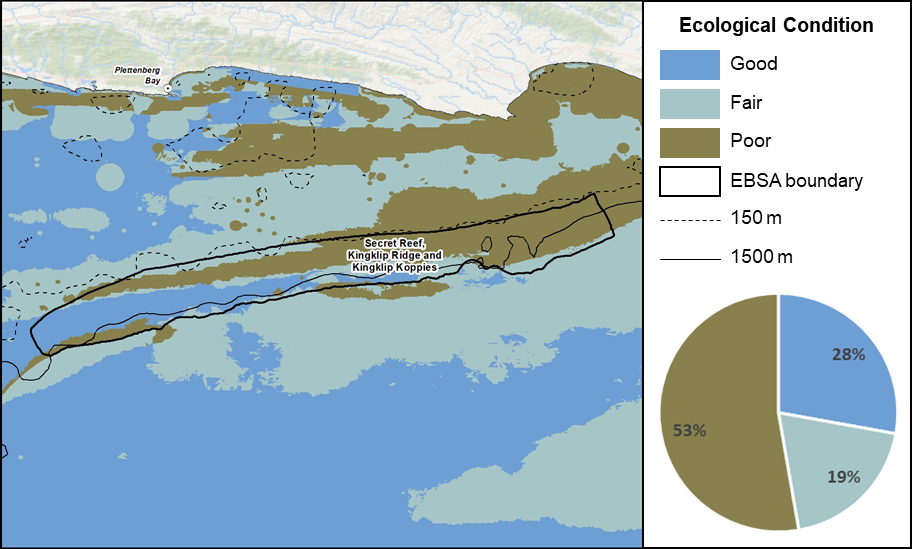
Kingklip Corals proportion of area in each ecological condition category.
Kingklip Corals is mostly in poor ecological condition (53%), with some portions that are still in good (28%) or fair (19%) ecological condition. Consequently, the bulk of EBSA is threatened, comprising Endangered (2%) and Vulnerable (57%) ecosystem types; the remaining 41% is Least Concern.

Kingklip Corals proportion of area in each ecosystem threat status category.
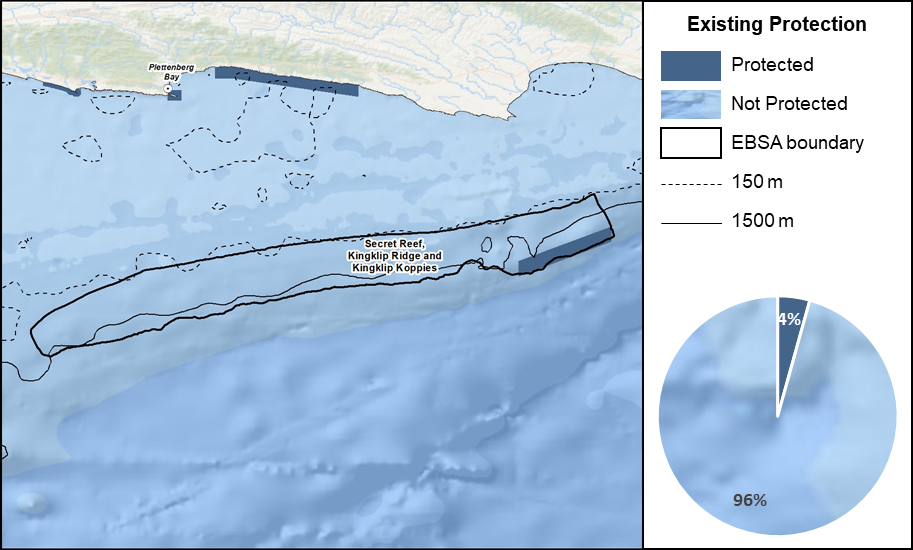
Kingklip Corals proportion of area in a Marine Protected Area (MPA).
Protection of features in MPAs has been improved following the proclamation of the Operation Phakisa MPA network, with the EBSA area within reserves increasing from no protection to 4% protection. The new MPA covers the Kingklip Ridge. This has improved the protection levels of some ecosystem types, but there are still some in the EBSA that are poorly or not protected.
Threat status, protection level and ecological condition of ecosystem types in the EBSA. Other key features are also listed.
|
Feature
|
Threat Status
|
Protection Level
|
Condition (%)
|
|
Good
|
Fair
|
Poor
|
|
Ecosystem Types
|
|
Agulhas Coarse Sediment Shelf Edge
|
VU
|
PP
|
7.1
|
15.8
|
77.1
|
|
Agulhas Plateau Mosaic
|
LC
|
MP
|
69.4
|
11.9
|
18.7
|
|
Kingklip Koppies
|
VU
|
NP
|
27.8
|
45.9
|
26.3
|
|
Kingklip Ridge
|
EN
|
MP
|
0.0
|
28.5
|
71.5
|
|
Southwest Indian Upper Slope
|
LC
|
WP
|
0.2
|
25.4
|
74.4
|
|
Other Features
|
-
Fragile scleractinian corals, stylasterine corals, bamboo corals and bryozoans
-
Clouds of plankton and hake
|
[Top]
-
There are eight pressures present in this EBSA, of which shipping is the only one that covers the entire EBSA extent and has the highest cumulative pressure profile.
-
Key pressures in this EBSA that most directly impact the features for which the EBSA is described include: offshore trawling, benthic (hake) longlining, midwater trawling, pelagic longlining, south coast rock lobster harvesting, linefishing (commercial and recreational), and oil and gas (exploration and production). These activities will need to be managed particularly well in order to protect the fragile benthic biodiversity, and hake stocks for which this EBSA is recognised.
-
For almost all pressures, the substantially larger portion of the activity (sometimes the entire footprint) is in the Impact Management Zone, and the Conservation Zone includes only two activities (shipping and offshore trawling) where the contribution to the EBSA’s pressure profile is more than 1%.
-
Only oil and gas (exploration and production) comprise <1% of the EBSA pressure profile
-
Activities in South Africa that are not present in this EBSA include: abalone harvesting, alien invasive species, beach seining, coastal development, coastal disturbance, dredge spoil dumping, gillnetting, kelp harvesting, mariculture, mean annual runoff reduction, mining (prospecting and mining), naval dumping (ammunition), oyster harvesting, tuna pole fishing, ports and harbours, prawn trawling, recreational shore angling, shark netting, small pelagics fishing, squid fishing, subsistence harvesting, inshore trawling, wastewater discharge, and west coast rock lobster harvesting; noting that some of these are coastal pressures that do not apply to offshore EBSAs.
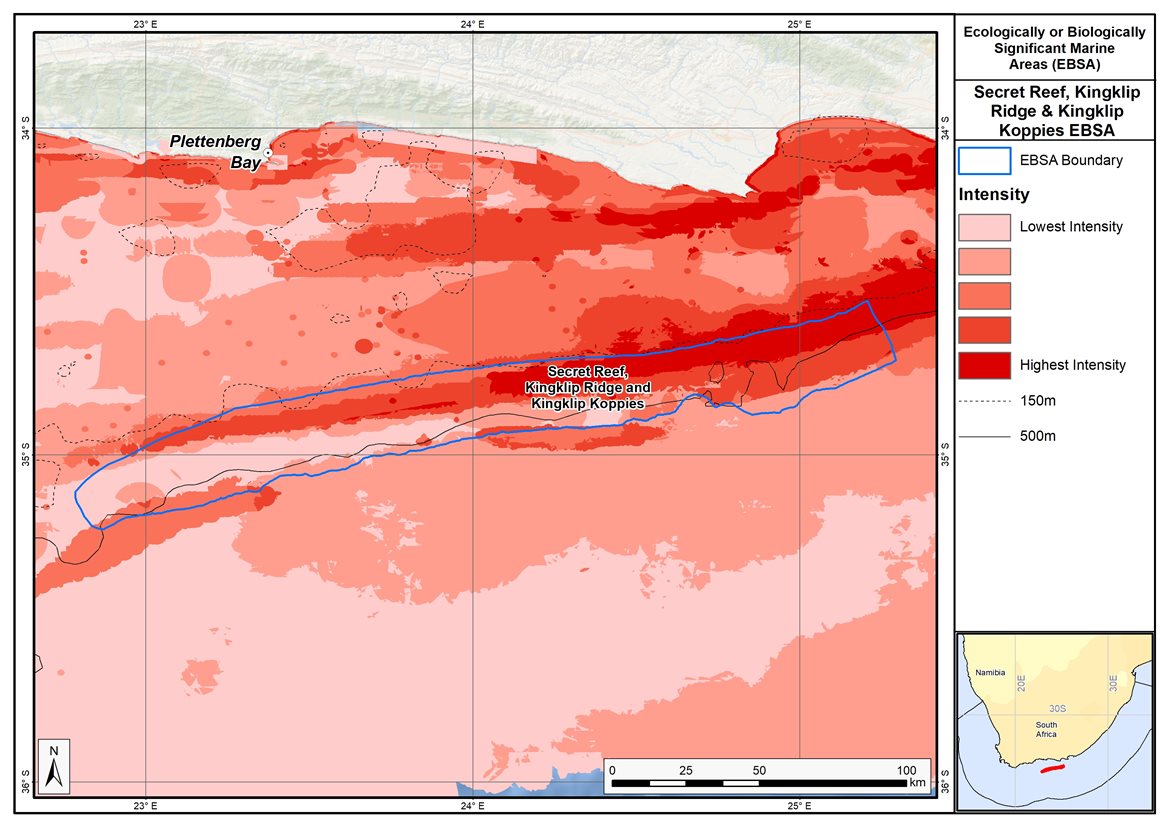
Map of cumulative pressure from all activities in the EBSA and surrounds. Darker reds indicate higher pressure intensity.
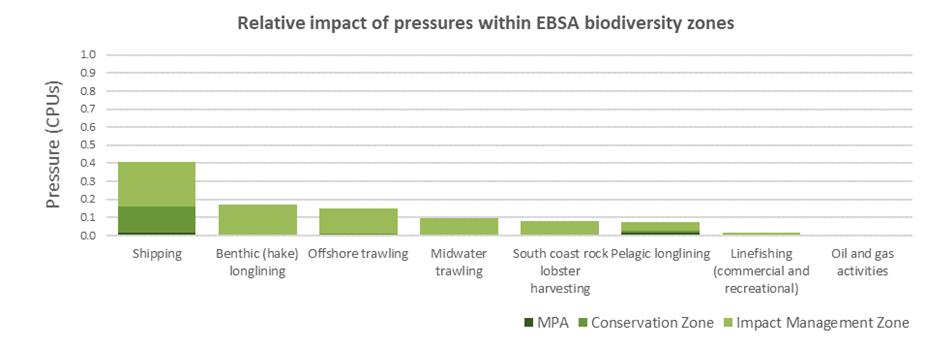
Pressure (in arbitrary cumulative pressure units, CPUs) summed for each pressure in the EBSA, per proposed EBSA biodiversity zone, ranked left (highest) to right (lowest) by the overall relative importance of pressures in this EBSA. Note that linefishing (commercial and recreational) and oil and gas (exploration and production) each comprise <1.2% of the EBSA pressure profile.
[Top]
Improved place-based protection of EBSA features should be pursued. In support of this, the EBSA is divided into a Biodiversity Conservation Zone and an Environmental Impact Management Zone, both comprising several areas within the EBSA. The aim of the Biodiversity Conservation Zone is to secure core areas of key biodiversity features in natural / near-natural ecological condition. Strict place-based biodiversity conservation is thus directed at securing key biodiversity features in a natural or semi-natural state, or as near to this state as possible. Activities or uses that have significant biodiversity impacts are incompatible with the management objective of this zone. If the activity is permitted, it would require alternative Biodiversity Conservation Zones or offsets to be identified. If this is not possible, it is recommended that the activity is Prohibited. Where possible and appropriate, the Biodiversity Conservation Zones should be considered for formal protection e.g., Marine Protected Areas or Other Effective Area-Based Conservation Measures (OECM). The aim of the Environmental Impact Management Zone is to manage negative impacts on key biodiversity features where strict place-based measures are not practical or not essential. In this zone, the focus is management of impacts on key biodiversity features in a mixed-use area, with the objective to keep biodiversity features in at least a functional state. Activities or uses that have significant biodiversity impacts should be strictly controlled and/or regulated. Within this zone, ideally there should be no increase in the intensity of use or the extent of the footprint of activities that have significant biodiversity impacts. Where possible, biodiversity impacts should be reduced.
As far as possible, the Biodiversity Conservation Zone was designed deliberately to avoid conflicts with existing activities. There is also one MPA that is wholly within the EBSA: Port Elizabeth Corals MPA. The activities permitted within this MPA are not considered as part of the EBSA management recommendations because these are as per the gazetted regulations.
Proposed zonation of the EBSA into Conservation (medium green) and Impact Management (light green) Zones. MPAs are overlaid in orange outlines, with the extent within the EBSA given in dark green. Click on each of the zones to view the proposed management recommendations.
Protection of features in the rest of the Conservation Zone may require additional Marine Protected Protection of features in the rest of the Conservation Zone may require additional Marine Protected Area declaration/expansion. Other effective conservation measures should also be applied via Marine Spatial Planning (MSP) to ensure that the existing activities/uses are appropriately controlled to ensure compatibility of activities with the environmental requirements for achieving the management objectives of the EBSA Biodiversity Conservation and Environmental Impact Management Zones.
Based on the compatibility of sea-use activities with the management objective of each EBSA zone (see table below, from the sea-use guidelines of the National Coastal and Marine Spatial Biodiversity Plan), it is recommended for MSP that compatible activities are managed as General activities, which are those that are permitted and regulated by current general rules and legislation. Activities that are conditional are recommended to be managed as Consent activities, which are those that can continue in the zone subject to specific regulations and controls, e.g., to avoid unacceptable impacts on biodiversity features, or to avoid intensification or expansion of impact footprints of uses that are already occurring and where there are no realistic prospects of excluding these activities. Activities that are not compatible are recommended to be Prohibited, where such activities are not allowed or should not be allowed (which may be through industry-specific regulations) because they are incompatible with maintaining the biodiversity objectives of the zone. These recommendations are subject to stakeholder negotiation through the MSP process, recognizing that there will likely need to be significant compromises among sectors. It is emphasized, as noted above, that if activities that are not compatible with the respective EBSA zones are permitted, it would require alternative Biodiversity Conservation Zones or offsets to be identified. If this is not possible, it is recommended that the activity is Prohibited.
List of all sea-use activities, grouped by their Marine Spatial Planning (MSP) zones, and scored according to their compatibility with the management objective of the EBSA’s Biodiversity Conservation Zone (i.e., Critical Biodiversity Area, CBA) and Environmental Impact Management Zone (i.e., Ecological Support Area, ESA). Activity compatibility is given as Y = yes, compatible, C = conditional or N = not compatible, with major activities that are present in the EBSA shaded in grey.

[Top]

Proposed zonation of the EBSA, with the cumulative intensity footprint of activities within the EBSA (sorted highest to lowest) given relative to the national footprint of those activities to illustrate feasibility of management interventions.
Almost a fifth of the country’s midwater trawling is within the EBSA, almost exclusively within the Impact Management Zone. It is recommended to continue as a Consent activity in both EBSA zones. The linefisheries in the EBSA include benthic (hake) longlining, pelagic longlining and linefishing (commercial and recreational); these too are present almost entirely in the Impact Management Zone and are recommended to continue as Consent activities in both EBSA zones. Offshore trawling is recommended to continue in the Impact Management Zone as a Consent activity, but it is incompatible with the management objectives of the Conservation Zone and is therefore recommended to be Prohibited in that zone where, after revision of the zone, it currently does not occur. Oil and gas (exploration and production) occur to a very small degree in the EBSA, and is exclusively in the Impact Management Zone, where is may continue subject to appropriate regulation. Shipping is recommended to continue under current general rules and legislation. Thus, in all cases, the EBSA zonation has no or minimal impact on the national footprint for the listed marine activities. Note that the footprints of these activities are given based on their footprint prior to proclamation of the new Port Elizabeth Corals MPA.
Management recommendations for MPAs
Since the inception of the MARIMSA Project, protection has increased in the EBSA with the declaration of the Port Elizabeth Corals MPA in 2019. It is recommended that full operationalisation of the new MPA is implemented, including a management plan, resourcing, and adequate staffing and law enforcement. Potential MPA expansion within the EBSA should be explored to ensure that the features for which the EBSA was described receive adequate protection. Other tools could also be explored as interim measures towards formal protection in MPAs, e.g., a fisheries management area at Secret Reef. See Future Process below for more details.

Marine protected areas (MPAs) in the Kingklip Corals EBSA. Land-based protected areas are from DFFE (2021).
[Top]
Management recommendations for MSP
Developing the biodiversity sector’s input to the national Marine Spatial Planning process
Following the initial management recommendations proposed for Kingklip Corals, outlined above, South Africa iteratively developed a National Coastal and Marine Spatial Biodiversity Plan (NCMSBP; Harris et al. 2022a,b) that underpinned the Marine Biodiversity Sector Plan (DFFE 2022). The latter constitutes the biodiversity sector’s input into the national Marine Spatial Planning (MSP) process. The NCMSBP comprises a Map of Critical Biodiversity Areas and Ecological Support Areas (abbreviated to CBA Map), and a set of sea-use guidelines that indicate activity compatibility with the management objectives of each of the CBA Map categories. These two components form the basis for the proposed biodiversity zones and management recommendations for the Marine Area Plans. EBSAs are an integral part of the NCMSBP, and thus the Biodiversity Sector Plan. Therefore, these products informed the proposed zoning and sea-use guidelines for EBSAs in the MSP process.
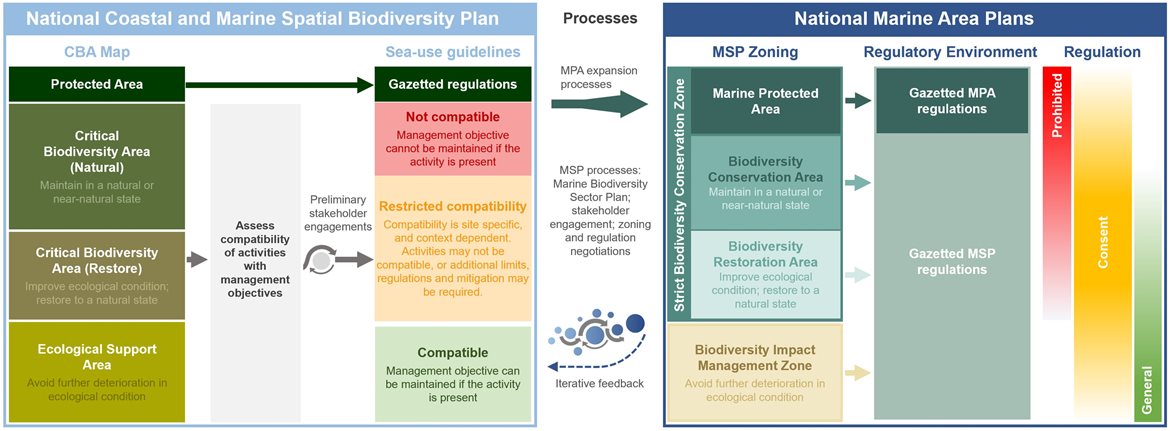
Schematic diagram illustrating that the National Coastal and Marine Spatial Biodiversity Plan will inform the Marine Area Plans through the Marine Biodiversity Sector Plan (DFFE 2022), and will be iteratively updated and refined based on feedback. The process for deriving the sea-use guidelines is also shown, indicating that it is based on an assessment of activity compatibility with the management objective of Critical Biodiversity Area (CBA) Natural, CBA Restore and Ecological Support Areas (ESAs). Marine Protected Area (MPA) expansion, focussing on CBAs, will also take place in a separate but related process. The outcomes of the Marine Spatial Planning and MPA expansion processes will be incorporated into the Marine Area Plans and will be fed back into future updates of the National Coastal and Marine Spatial Biodiversity Plan.
[Top]
Proposed Zones
The proposed biodiversity zones for the EBSA in MSP comprises two types: a Strict Biodiversity Conservation Zone; and a Biodiversity Impact Management Zone. The former has three sub-categories: Marine Protected Area; Biodiversity Conservation Area; and Biodiversity Restoration Area. All of these zones and sub-categories are found in Kingklip Corals.
Port Elizabeth Corals MPA is the only MPA in this EBSA. It is managed according to the gazetted management regulations for this MPA. About half of the rest of the Strict Biodiversity Conservation Zone is a Biodiversity Conservation Area, where the management objective of this zone is to maintain the sites in natural or near-natural ecological condition. The remaining half of the Strict Biodiversity Conservation Zone comprises a Biodiversity Restoration Area, where the management objective of the zone is to improve the ecological condition of the sites and, in the long term, restore them to a natural / near-natural state, or as near to that state as possible. As a minimum, avoid further deterioration in ecological condition and maintain options for future restoration. The rest of the EBSA is a Biodiversity Impact Management Zone. This is a multi-use area that may already be heavily impacted, but needs to be kept ecologically functional because it is still important for marine biodiversity patterns, ecological processes, and ecosystem services. Therefore, the management objective is to avoid further deterioration in ecological condition.

Proposed biodiversity zones for the Kingklip Corals EBSA for South Africa’s Marine Area Plans.
Proposed Sea-Use Guidelines
All sea-use activities were listed and evaluated according to their compatibility with the management objective of each of the proposed biodiversity zones. Where various aspects of an activity have a different impact on the environment, these were reflected separately, e.g., impacts from petroleum exploration are different to those from production. Activity compatibility was based largely on the ecosystem-pressure matrix from the NBA 2018 (Sink et al. 2019), which is a matrix of expert-based scores of the functional impact and recovery time for each activity on marine ecosystems (adapted from Halpern et al. 2007). Activities were then classified into those that are Compatible, Not Compatible or have Restricted Compatibility with the management objectives of each proposed biodiversity zone. This classification followed a set of predefined principles that account for the severity and extent of impact, similar to the IUCN Red List of Ecosystems criterion C3 (Keith et al. 2013). Some exceptions and adjustments were made based on initial discussions as part of the MSP process.
Sea-use guidelines for Kingklip Corals. List of all sea-use activities, grouped by their broad sea use and Marine Spatial Planning (MSP) Zones, and categorised according to their compatibility with the management objective of Strict Biodiversity Conservation Zone: Biodiversity Conservation Area (SBCZ: BCA); Strict Biodiversity Conservation Zone: Biodiversity Restoration Area (SBCZ: BRA); and the Biodiversity Impact Management Zone (BIMZ). Activity compatibility is given as Y = yes, compatible, R = restricted compatibility, or N = not compatible. Strict Biodiversity Conservation Zone: Marine Protected Areas (SBCZ: MPA) are managed according to their gazetted regulations.
Proposed management recommendations for activities with each of the different compatibility ratings:
-
Compatible: Activities should be allowed and regulated by current general rules. Notwithstanding, there should still be duty of care, possibly requiring monitoring and evaluation programmes, to avoid unintended cumulative impacts to the biodiversity features for which this area is recognised.
-
Restricted compatibility: A robust site-specific, context-specific assessment is required to determine the activity compatibility depending on the biodiversity features for which the site was selected. Particularly careful attention would need to be paid in areas containing irreplaceable to near-irreplaceable features where the activity may be more appropriately evaluated as not permitted. The ecosystem types in which the activities take place may also be a consideration as to whether or not the activity should be permitted, for example. Where it is permitted to take place, strict regulations and controls over and above the current general rules and legislation would be required to be put in place to avoid unacceptable impacts on biodiversity features. Examples of such regulations and controls include: exclusions of activities in portions of the zone; avoiding intensification or expansion of current impact footprints; additional gear restrictions; and temporal closures of activities during sensitive periods for biodiversity features.
-
Not compatible: The activity should not be permitted to occur in this area because it is not compatible with the management objective. If it is considered to be permitted as part of compromises in MSP negotiations, it would require alternative Strict Biodiversity Conservation Zones and/or offsets to be identified. However, if this is not possible, it is recommended that the activity remains prohibited within the Strict Biodiversity Conservation Zone.
[Top]
Research Needs
There are no specific research needs for this EBSA in addition to those for all EBSAs. However, it is highlighted here that biological sampling and surveys are especially recommended to improve the foundational knowledge of this site. Future research is also needed to determine the extent of connectivity among the three key benthic features (Secret Reef, Kingklip Koppies, and Kingklip Ridge).
Future Process
There needs to be full operationalisation and practical implementation of the Port Elizabeth Corals MPA, including a management plan, staffing, and resources. There also needs to be full operationalisation and practical implementation of the proposed zoning in the national marine spatial plan, with gazetted management regulations following the proposed management recommendations outlined above. Possible MPA expansion within the EBSA should be explored, with relevant areas included into focus areas that can be considered further in a dedicated MPA expansion process with adequate and meaningful stakeholder engagement. Other tools could also be explored as interim measures towards formal protection in MPAs, e.g., a fisheries management area at Secret Reef.
References
DFFE, 2021. South African Protected Areas Database (SAPAD). Available at: https://egis.environment.gov.za/protected_and_conservation_areas_database.
DFFE, 2022. Biodiversity Sector Plan: Input for Marine Spatial Planning (MSP). Department of Forestry, Fisheries and the Environment, Cape Town.
Halpern, B.S., Selkoe, K.A., Micheli, F., Kappel, C.V., 2007. Evaluating and Ranking the Vulnerability of Global Marine Ecosystems to Anthropogenic Threats. Conservation Biology 21, 1301–1315.
Harris, L.R., Holness, S.D., Kirkman, S.P., Sink, K.J., Majiedt, P., Driver, A., 2022. National Coastal and Marine Spatial Biodiversity Plan Version 1.2 (Released: 12-04-2022). Nelson Mandela University, Department of Forestry, Fisheries and the Environment, and South African National Biodiversity Institute, South Africa.
Harris, L.R., Holness, S.D., Kirkman, S.P., Sink, K.J., Majiedt, P., Driver, A., in review. A robust, systematic approach for developing the biodiversity sector’s input for multi-sector Marine Spatial Planning. Ocean & Coastal Management.
Keith, D.A., Rodríguez, J.P., Rodríguez-Clark, K.M., Nicholson, E., Aapala, K., Alonso, A., Asmussen, M., Bachman, S., Basset, A., Barrow, E.G., Benson, J.S., Bishop, M.J., Bonifacio, R., Brooks, T.M., Burgman, M.A., Comer, P., Comín, F.A., Essl, F., Faber-Langendoen, D., Fairweather, P.G., Holdaway, R.J., Jennings, M., Kingsford, R.T., Lester, R.E., Nally, R.M., McCarthy, M.A., Moat, J., Oliveira-Miranda, M.A., Pisanu, P., Poulin, B., Regan, T.J., Riecken, U., Spalding, M.D., Zambrano-Martínez, S., 2013. Scientific Foundations for an IUCN Red List of Ecosystems. PLoS ONE 8, e62111.
Sink, K.J., Holness, S., Skowno, A.L., Franken, M., Majiedt, P.A., Atkinson, L.J., Bernard, A., Dunga, L.V., Harris, L.R., Kirkman, S.P., Oosthuizen, A., Porter, S., Smit, K., Shannon, L., 2019. Chapter 7: Ecosystem Threat Status, In South African National Biodiversity Assessment 2018 Technical Report Volume 4: Marine Realm. eds K.J. Sink, M.G. van der Bank, P.A. Majiedt, L.R. Harris, L.J. Atkinson, S.P. Kirkman, N. Karenyi. South African National Biodiversity Institute, Pretoria. http://hdl.handle.net/20.500.12143/6372.
[Top]